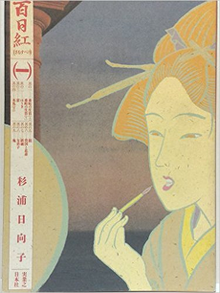Miss Hokusai
| Miss Hokusai | |

Cover of first volume of Miss Hokusai, reprinted in 1992
|
|
|
百日紅 (Sarusuberi) |
|
|---|---|
| Genre | Historical |
| Manga | |
| Written by | Hinako Sugiura |
| Published by | Jitsugyo no Nihon Sha |
| Demographic | Seinen |
| Magazine | Weekly Manga Sunday |
| Original run | 1983 – 1987 |
| Anime film | |
| Directed by | Keiichi Hara |
| Written by | Miho Maruo |
| Music by | Harumi Fuki, Yo Tsuji |
| Studio | Production I.G |
| Released | May 9, 2015 |
| Runtime | 90 minutes |
Miss Hokusai (百日紅 Sarusuberi?) is a Japanese historical manga series written and illustrated by Hinako Sugiura, telling the story of Katsushika Ōi who worked in the shadow of her father Hokusai. It was adapted into an anime film, Miss Hokusai, directed by Keiichi Hara, that was released in 2015.
The manga story consists of episodes which are not necessarily connected to each other. They feature Ō-Ei and her life in Edo, as she works in the studio of her father. The younger sister appears in one of the episodes.
The anime story begins in Edo in 1814, during the Edo period. Ō-Ei is one of the four daughters of the painter Tetsuzo, who later became known as Hokusai. The film takes place at the moment when Ō-Ei reaches adulthood, while her father, aged about fifty, is already a recognized artist in his country. The studio in which they both work is completely cluttered, she goes to her mother's place to eat but spends the night in the studio. Tetsuzo is known for his famous painting skills, such as painting the Great Daruma or two sparrows on a grain of rice. Ō-Ei has the talent and obstinacy from her father. She paints often at her desk, without signing her work, in order to complete the orders. She does not get any recognition for her talent.
The film alternates episodes of the life of Ō-Ei and her father and the painters that visit, especially Zenjirō Ikeda (Keisai Eisen), who later became known for his bijin-ga, and Kuninao Utagawa. Several scenes feature Japanese mythology and Buddhism. After accidentally damaging a Japanese dragon painting that her father had to deliver the next day, Ō-Ei had to repaint the dragon herself. During the night, a heavy storm breaks out and the dragon descends from the clouds. This could be the story from the Tang period, according to which there is a technique for capturing a dragon in a painting. The topic of ikiryō is also depicted, such as when Tetsuzo's astral hands fly, or when they investigate rumours about a famous oiran in the Yoshiwara district, whose astral head tries to leave her body during the night. The Amitābha Pure Land Buddha is also a theme, such as when the wife of a patron is losing her mind because of a painting of jigoku (Buddhist hell) by Ō-Ei. Tetsuzo realizes that Ō-Ei did "not finish" the painting and he completes it by adding the image of the Amitābha, which finally gives the wife peace. The Buddha makes another appearance with two Bodhisattvas in a dream sequence.
...
Wikipedia
